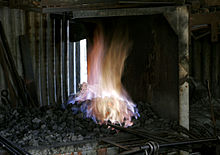Esse (fireplace)
The Esse , from Old High German essa , "stove of the metalworker", refers to an open hearth with an extractor and additional air supply, which is used to warm up (heat up) metal parts during forging . Thanks to the adjustable supply of air-oxygen, which historically took place with a manually operated bellows and now with an electric fan , the forge fire is brought to the required or desired temperature for forging the metal parts, depending on the forming process. The stationary forge is therefore the most important facility in a forge , while the so-called field smithy uses a mobile forge ( field forge ) .
Colloquially, the forge is sometimes simply referred to as a "smith's fire" in the craft sector. At the same time, the term “Esse”, which originally comes from the tradition of the blacksmith's trade , is generally applicable in the industrial sector .
As fuel is usually coal , in particular those with high carbon contents (eg. As coal , charcoal or bituminous coal used). Coal-fired meals are designed accordingly for grate firing .
For some years now there has also been food that is fired with propane gas and therefore can do without smoke extraction systems ( chimneys ), but not ventilation. Gas-fired meals, however, are usually more expensive to run than coal-fired meals, and the traditional blacksmiths who are mostly aware of their tradition consider them to be “not in keeping with tradition”.
history
The prevention of a fire served the orders under Palatine Count Karl IV. From the year 1772 about the removal of chips every evening in the workshops of the carpenters , Wagner and Bender , as well as the daily extinguishing of the stove and stove fire at certain evening hours. According to the simultaneous building regulations, no more wooden chimneys were allowed to be erected, no more wooden hoses were allowed to be installed, which had to lead the smoke of the fireplace to the fireplace , as it was forbidden to lead stovepipes out of the window.
Insights
Forge of a blacksmith in Loi-Huno ( East Timor )
A forge as the speaking coat of arms of the municipality of Essingen (Württemberg)
literature
- Hårvard Bergland: The art of forging. The great textbook of traditional technology. 4th, unchanged edition of the German edition. Wieland, Bruckmühl 2013, ISBN 978-3-9808709-4-8 , pp. 13–32: Chapter 2: Fuel, smoke ventilation and food .
Web links
Individual evidence
- ^ Franz-Josef Sehr : The fire extinguishing system in Obertiefenbach from earlier times . In: Yearbook for the Limburg-Weilburg district 1994 . The district committee of the Limburg-Weilburg district, Limburg-Weilburg 1993, p. 151-153 .





